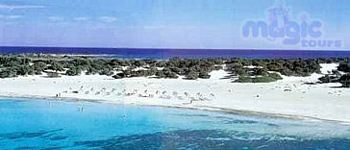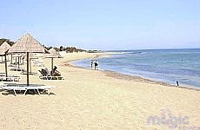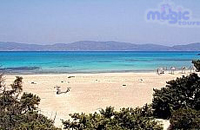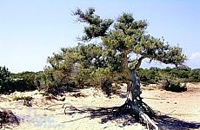"Chrissi" island or Gaidouronissi (Donkeys island).

A small picturesque uninhabited island with woods of cedar, the old chapel of St Nicholas, alluring golden sandy beaches and the facilities at the Municipal canteen.
 For Ideal long lazy hours swimming and sunbathing, just 8 miles south, from the port of Ierapetra (frequent daily boat services). The residents of Ierapetra call it "The Island", as there is a special relationship between them, lost in the depths of time.
For Ideal long lazy hours swimming and sunbathing, just 8 miles south, from the port of Ierapetra (frequent daily boat services). The residents of Ierapetra call it "The Island", as there is a special relationship between them, lost in the depths of time.From the middle the end of September there are daily cruise by boats to "Chrissi", departing from the port of Ierapetra.
The relief
"Chrissi" is almost flat, with an average height of 10 m. From a certain distance, it seems like a thin line of land in the middle of the sea. Its greatest length is 5 km, it has an average width of 1 km and cover almost 5 km². The highest spot is to the east on "Kefala" (the head), and is the forester's lookout, with a view over the whole island.On the western side of the island, where the lighthouse is, there is the second highest spot (21 cm). The average inclination is 3-5%. There are some steep slopes along the coasts but they are not greater than 5 m.
 About 700 m east of "Chrissi' is "Mikronisi", a rocky islet which covers 11,7 hectares.
About 700 m east of "Chrissi' is "Mikronisi", a rocky islet which covers 11,7 hectares.The waters around the islands are shallows. Up to 1 km to the north and 500 m to the south, the depth does not exceed 10 m, while the 5 m depth contour encompasses both of the islands.
Rocks and soil
The basic rocks of "Chrissi" (diabases, peridotids and gabbros) were created by the solidification of Iava, ejected by an underwater volcano millions of years ago.
 On most of the island, sedimentary rocks (mainly ire stones, breccias and sandstones) overlie the original volcanic base layer. While walking around the island, visitors will be impressed by the colours of the rocks (reddish brown, greenish grey and black).
On most of the island, sedimentary rocks (mainly ire stones, breccias and sandstones) overlie the original volcanic base layer. While walking around the island, visitors will be impressed by the colours of the rocks (reddish brown, greenish grey and black).The larger part of Chrissi's surface is covered by sand. On the flat areas the ground is relatively solid and consist of fine reddish sand, mainly covered by moss and lichens.
At the areas where there are sand dunes, the sand is yellow and course. Complex underground roots of the cedar and their leaves, which actually touch the ground, mainly supported the sand.
